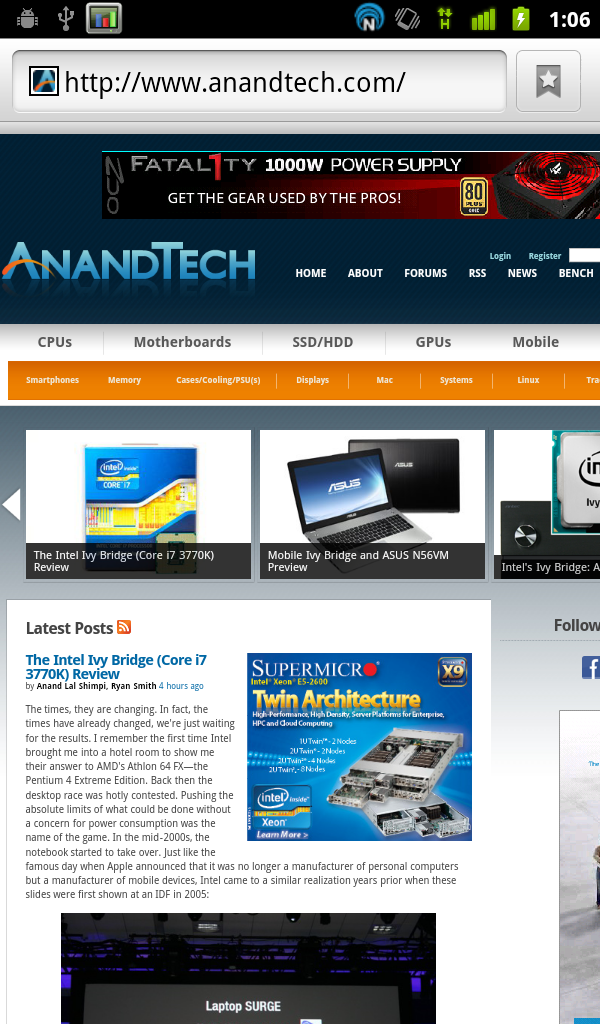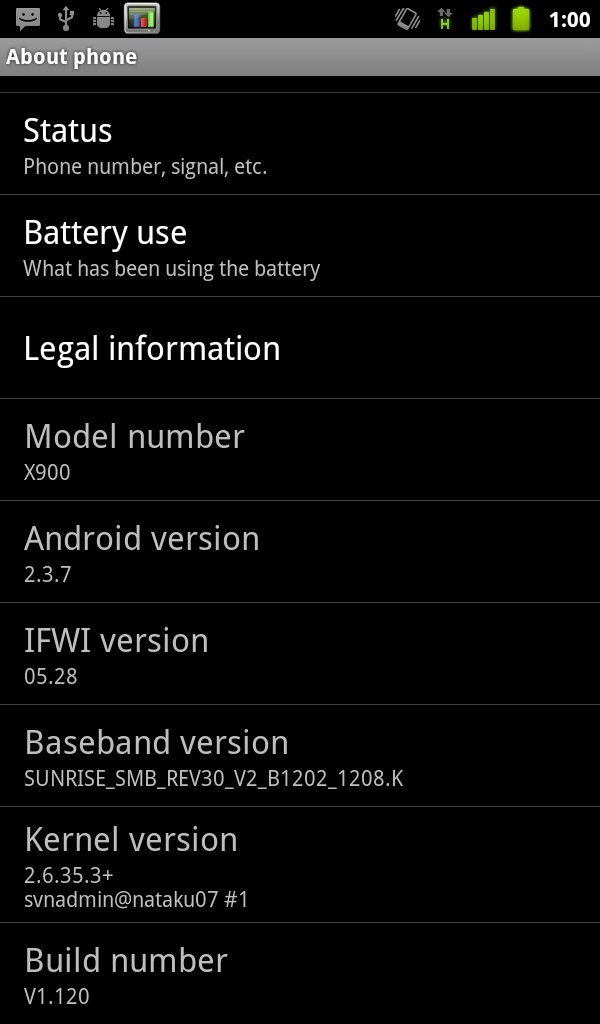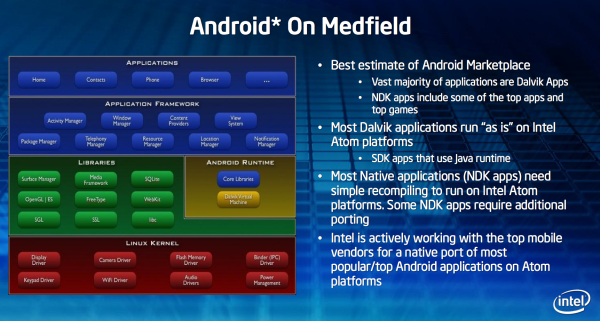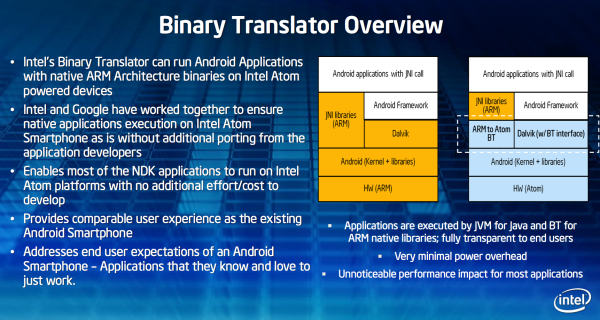Lava Xolo X900 Review - The First Intel Medfield Phone
by Brian Klug on April 25, 2012 6:00 AM ESTAndroid on x86 and Binary Translation
So the other major and obvious piece of the puzzle is what changes were required to make Android and all of its applications run on x86. Android itself has already been built for x86 before, and again we’ve seen and played with it running all the way back at IDF 2010. That part of the puzzle is relatively understood, but the devil again is in the edge cases. Among the things that need massaging for x86 are the Dalvik VM, x86 JIT, NDK, and JavaScript engine.
Android itself is actually an ideal platform for Intel to target, as the vast majority of Android applications in the Play Store run atop the Dalvik VM and use the Android Framework (75–80% are commonly cited numbers, depending on how you’re counting). The rest either are Dalvik VM applications that run and use JNI (Java Native Interface) libraries that are built for ARM only, or NDK (Native Development Kit) applications. So where does Intel’s binary translation secret sauce fit into all this? Simply put, Intel’s binary translation is the mitigation for both libraries and NDK applications that haven’t yet been ported to x86, and allows the device to expose itself as supporting two application binary interfaces (ABIs), both x86 and ARMv5, in fact this is easy enough to see upon superficial inspection of build.prop:
ro.product.cpu.abi=x86 ... ro.product.cpu.abi2=armeabi
In the case of Dalvik applications, developers don’t need to do anything. Thankfully again this is the vast majority of Android applications you encounter on a daily basis - they just work, given that Intel has made Dalvik work with x86 and spit out the right machine code.
NDK applications are also easy enough to mitigate - the developer simply needs to recompile the NDK project, which supports ARMv5 (‘armeabi’), ARMv7 (‘armeabi-v7a’), and x86 (‘x86’). Building for x86 will deliver code that’s tailored (unsurprisingly) exactly to the Saltwell CPU feature set, or more explicitly what you’d get by running GCC with the compiler flags “-march=i686 -msse3 -mstackrealign -mfpmath=sse” - this is all outlined in the CPU-ARCH-ABIS.html document as part of the NDK documentation. The resulting APK can be packaged as a “fat binary” with machine code for all three platforms, and upon install only the proper one is unpacked and installed.
The remaining two cases are where binary translation come in. In the case of applications that haven’t been rebuilt with the NDK to target x86, the binary translator magic kicks in and translates the armeabi version into x86. The same applies for applications that request some JNI libraries that are currently ARM only.
Intel outlines this in a number of slides which have made their way online, and the process is virtually completely transparent to end users and Dalvik applications. The x86 compatible Dalvik VM is a part of the OS, as are the ARM to Atom BT phase for JNI libraries. ARM native NDK apps on the other hand are translated by Intel in the cloud, validated against Intel's Android x86 emulator and pushed to the Play Store. The point is the bulk of binary translation happens away from the device itself and running on much faster Xeons in the cloud. As binary translation requires more cycles than natively running the code, which in turn consumes additional power, this was the only route for Intel to ensure that Atom would remain power efficient (and high performance) even on non-native NDK apps. Update: Intel has clarified and informed us there is no cloud aspect to binary translation, it is 100% done on the device for ARM NDK applications.
It's still unclear just how long this process takes after a developer has uploaded a non-x86 NDK app to the Play Store, or what happens if the process fails to validate for whatever reason (Does Intel get in touch with the developer? Is the app forever excluded?). Intel is being unusually vague about how all of this works unfortunately.
The combination of all of these efforts should result in over 90% of the apps in the Play Store working right away. What about in our experience? We discuss that next.
Software: Nearly Flawless
The X900 that I was sent came running Android 2.3.7, which is the latest version on the 2.3 branch. Xolo intends to deliver an Android 4.0.3 update later, and Intel internally has its own 4.0.x image stable and ready to go, which we’ve seen running on the FFRD a bunch before. It’s a bit odd to see things going this way when 4.0.x is clearly already ready, but no doubt some logistical issues with carrier support are the final hurdle. I’m eager to check out Intel’s 4.0.x port and intend to update when that happens.


Xolo and Intel have basically left things entirely stock with the X900. The notifications shade has one minor positive change - inclusion of the power controls, and Swype is bundled in addition to the stock Android 2.3 keyboard. There’s one Xolo Care support application preloaded, and basically nothing else. I can honestly say this is the least preloaded junk I’ve ever seen on a non-Nexus device.


So the next logical step is talking about how well Android and its apps work on x86 in practice, and the answer is unsurprisingly that almost everything is perfect. I installed about 80% of all the Android applications I’ve ever installed on any Android phone (thanks to the new Google Play ‘All’ tab) and nearly all of them worked perfectly. In fact, all of my daily driver applications work flawlessly: Twitter for Android, Baconreader, Speedtest.net, Barcode Scanner, Astro, Dropbox, Facebook, GPS Test Plus, GPS Status, Instagram, IP Cam Viewer, GTA III, Remote Desktop, Swiftkey X, and WiFi Analyzer all work perfectly.


That said there are indeed a few edge cases where things don’t seem to be perfect. For one, Flash 11 isn’t available for the X900, and throws an error in the market. The device does come preloaded running Flash 10.3 however, which gets the job done although is a bit dated. In addition, although Netflix would download, the installer would throw a ‘package file invalid’ error upon install. This is what leads me to think there’s some APK interception in the cloud and perhaps translation up there, and Netflix DRM not translating, but that’s speculation. Other than this, everything else I encountered works flawlessly, I wager your average Android user wouldn't be able to tell that this is running on a completely different architecture.












106 Comments
View All Comments
jwcalla - Wednesday, April 25, 2012 - link
Well... it's competitive. Ultimately it'll come down to who has the most desirable device. We know Apple has it's iPhone... Samsung the Galaxy S... Motorola the Droid Razr, etc. Intel would need to get in with one of those companies and be a top device to be accepted. Nobody is going to buy it just because it's Intel. (Except the fanboys of course.)dt1561 - Wednesday, April 25, 2012 - link
Looks cool but nothing extraordinary.fic2 - Wednesday, April 25, 2012 - link
Not that it matters much but does the display use Gorilla Glass?snoozemode - Wednesday, April 25, 2012 - link
Sure it's fun that Intel finally has proven that x86/Atom works in a smartphone, but the overall result is just a very bland phone that's not superior at anything really. And with a price of $420.. Why would anyone buy this?A5 - Wednesday, April 25, 2012 - link
That's $420 with no contract. Considering the average carrier subsidy is $300-$400, this is a firmly mid-range device.fm123 - Thursday, April 26, 2012 - link
That is the price in India, which could be a completely different situation than other countries.sonicmerlin - Wednesday, April 25, 2012 - link
So given the nature of x86, can we self-install other compatible operating systems such as an x86 port of MeeGo? I'm *very* interested in using MeeGo outside of the N9. What about the x86 ICS image that Google makes available on its own website? Are there any customization or tweaking requirements, or can we install any new OS the same way we would install Linux or Windows on typical x86 hardware?That would be the ultimate advantage of an x86 phone or tablet, no?
Finally, the battery tests here don't discuss standby battery life. That's always been an issue with Android, and is why every other OS seems to have much longer battery life than Android. We don't use our smartphones the way these battery torture tests suggest we do. Could you please download an app like Battery Monitor Widget and indicate how many mA are being used during standby?
dcollins - Wednesday, April 25, 2012 - link
Installing a new OS requires supported drivers. MeeGo could be installed in theory if you ported the necessary drivers from Android. They are both Linux based, so this is theoretically possible, but it will require a lot of hacking and technical expertise. The Windows driver model is totally different so you would have to reverse engineer drivers from scratch. That's not going to happen.This fight is not about x86 versus ARM as ISAs. It's about Intel versus ARM licensees: who can develop a faster, lower power chip? If Intel does their job well, the ISA shouldn't matter to the end user.
sonicmerlin - Thursday, April 26, 2012 - link
I think you misunderstand. MeeGo already provides support for x86. Technically it's now "Tizen", but regardless it's been developed with both ARM and x86 in mind. My main question is whether we can self-install an x86 port of MeeGo (or Tizen) onto this phone?fteoath64 - Saturday, April 28, 2012 - link
¨This fight is not about x86 versus ARM as ISAs. It's about Intel versus ARM licensees¨It blows down to just that!. The cost efficiency of ARM chips will just kill any chance of Intel getting into this market. Just look at a completely built Android handset made in china with retina display for $119. A retailer selling it for $160-199 will made heaps, if billions of units are involved. All licenses of chips and Android are legit. Not copycat stuff. Genuine Cortex A9 licenses.
It comes at a time when having 4-5 suppliers of ARM chips have made the market very resilient, something a single supplier can never do. So I say to Intel again, get an ARM license and play this game the right way. You can innovate very nicely with competition, and you really need that competition to keep your edge.